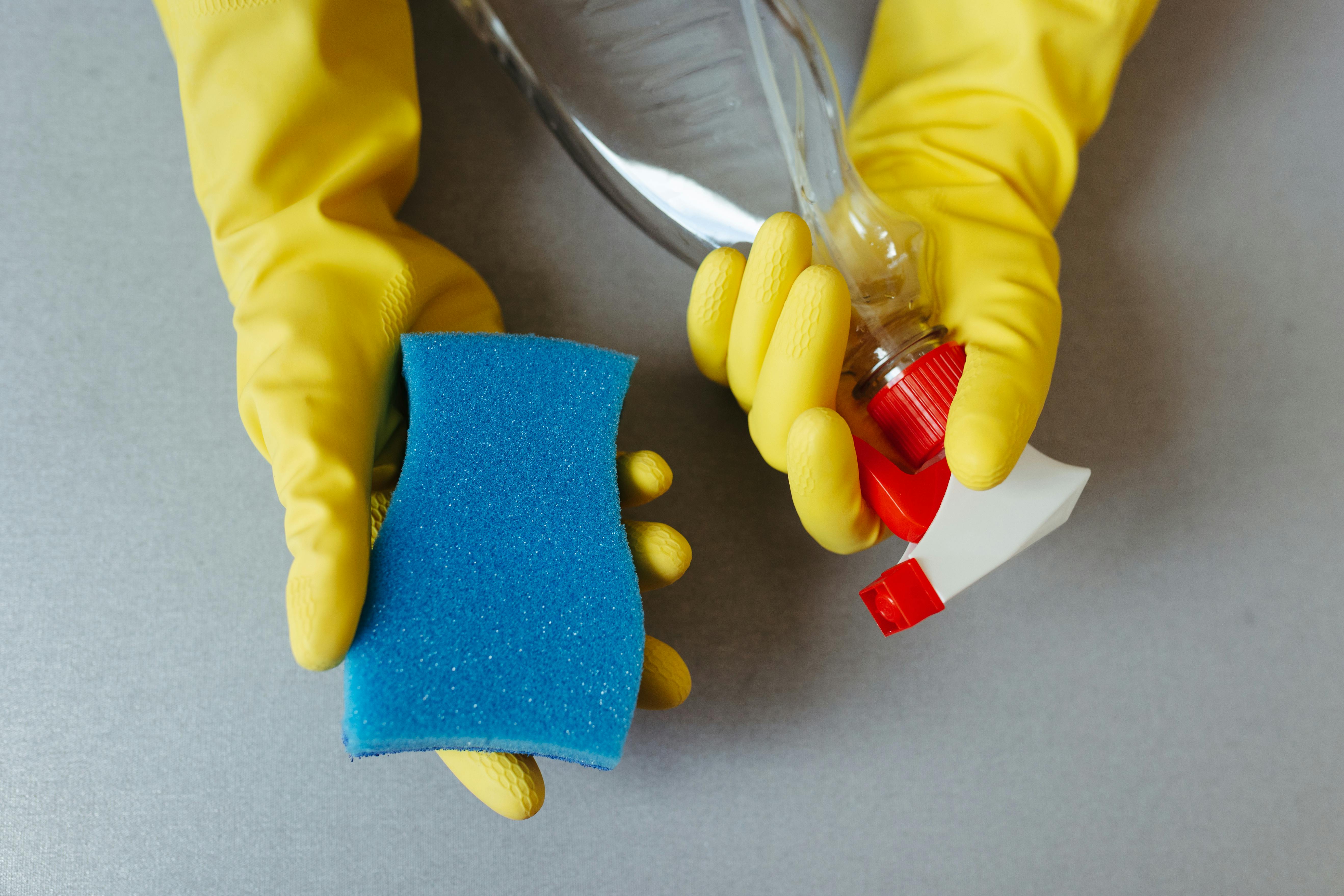Your walls do more than hold up your home—they set the tone for every room. Over time, however, they can collect dust, stains, and grime, especially in high-traffic areas. That said, knowing how to clean dirt off painted walls regularly can help you maintain a healthy, beautiful home.
In this article, we’ll walk you through some tips on how to clean your painted walls–from preparation to removing stubborn stains and mould–and how to maintain their pristine condition.
Preparing for Wall Cleaning
Before you start, proper preparation will make the cleaning process smoother and more time-efficient.
Here’s what you’ll need to do:
Gather Supplies
To clean painted walls effectively without damaging the surface, you must have the necessary supplies on hand. Some of these include:
- Mild dish soap or grease-cutting detergent
- White vinegar
- Baking soda
- Melamine sponges (e.g., Magic Erasers)
- Microfibre cloths and soft sponges
- Buckets, warm water, and vacuum brush attachments
Prepare the Area
A little preparation goes a long way in avoiding accidents or unnecessary mess. By clearing the area and taking precautions, you’ll keep your floors, furniture, and walls safe throughout the process.
Here’s how to prep your area for cleaning your painted walls:
- Move Furniture: Push furniture away from the walls or cover it with protective sheets.
- Cover the Floor: Use a drop cloth or old towels to catch drips and prevent water damage.
- Test Cleaning Solutions: Before applying any cleaner, test it on a small, inconspicuous area of the wall to ensure it doesn’t discolour or damage the paint.
How to Clean Your Painted Walls
Cleaning your painted walls can be broken down into two main approaches: general cleaning for everyday dirt and deep cleaning for tougher stains and grime. Here’s how to do it:
General Cleaning
Routine cleaning helps remove dust and grime before they become more challenging to tackle.
To pull this off efficiently:
- Dust First: Use a dry microfibre cloth, vacuum brush attachment, or dry mop to remove loose dust. Start from the top and work your way down.
- Prepare a Cleaning Solution: Mix warm water with a small amount of mild dish soap.
- Work in Sections: Clean the walls in small sections; start from the bottom and move upwards. This method helps prevent streaks.
- Rinse and Dry: Wipe each section with a clean, damp cloth to remove soap residue. After that, blot dry with a towel.
Deep Cleaning
Sometimes, regular cleaning isn’t enough, and your walls need a deeper cleaning to remove tough stains or accumulated grime. Check out these simple tips on how to restore your painted walls to their former condition:
- Grease and Stains: Use a grease-cutting detergent diluted with warm water. Gently scrub the area with a sponge, then rinse thoroughly.
- Mildew Spots: Mix one part bleach and three parts water. Apply carefully to the affected area, let it sit for a few minutes, and rinse well with clean water. Wear gloves and ensure your room has proper ventilation.
- Rinsing and Drying: Once cleaned, rinse with water and dry to prevent residue or watermarks.
Cleaning Different Paint Finishes
Knowing how to clean painted walls starts with understanding the type of paint finish, as each requires specific cleaning techniques to avoid damage.
- Matte/Flat Paint: Use gentle, non-abrasive cleaners. Avoid scrubbing, as matte finishes are more delicate and prone to damage.
- Glossy/Semi-Gloss Paint: These finishes are more durable. For tough stains on your walls, a mix of water and white vinegar works well.
- Eggshell/Satin Paint: Stick to mild dish soap and water, avoiding harsh chemicals that could dull the paint’s sheen.
Removing Stubborn Stains
Even with general cleaning, some stains require extra effort.
Dirt and Scuff Marks
Scuff marks from shoes or furniture can detract from the overall appearance of your walls. If you’re wondering how to clean dirt off painted walls, these simple techniques will help you remove marks effectively:
- Dirt and Scuff Marks: Gently dab with a cloth soaked in vinegar-water mixture. You can also use a melamine sponge to gently remove dirt and scuff marks.
- Light Scuffs: Often, a damp microfibre cloth will buff these away. Use circular motions for an even finish. For more stubborn marks, apply a small amount of non-abrasive cleaner to the cloth.
- Heavy Scuffs: Melamine sponges are excellent for these, especially when cleaning walls in high-traffic areas such as hallways and near light switches. Before proceeding, test the sponge on a hidden area to ensure it doesn’t damage your HDB painting.
Oil and Grease Stains
Oil and grease stains often appear in kitchens or near handprints, but knowing how to clean painted walls can make tackling these stains simple.
To remove oil or grease stains on your walls:
- Fresh Stains: Baking soda is your friend. Sprinkle it directly onto the stain to absorb the grease. Let it sit for 10 minutes before wiping it clean with a dry cloth.
- Set-in Stains: Mix warm water with a grease-cutting dish detergent. Apply with a sponge or cloth, gently scrub the stained area, and rinse with clean water.
Pro Tip: Avoid using hot water when removing oil and grease stains on your walls, as this can spread the grease.
Water Stains
Water stains on your painted walls can result from humidity, minor leaks, splashes or spills. Think about everyday occurrences like accidental splashes near sinks or bathtubs, rainwater dripping from coats or umbrellas, or even playful water fights that might get a little out of hand!
To remove water stains and keep your painted walls looking squeaky clean:
- Minor Stains: A simple solution of equal parts white vinegar and water in a spray bottle often does the trick.
- Persistent Stains: For watermarks or mineral deposits, a bleach-water solution (1 part bleach to 3 parts water) can be effective. Apply with a sponge, let it sit for a few minutes, and rinse thoroughly.
Preventive Tip: Fix any leaks or humidity problems that caused the stain to prevent recurrence.
Mould and Mildew
Mould can compromise indoor air quality and damage your walls if left untreated. As such, learning how to remove mould from painted walls is essential to protect your home and health.
- Light Mould Growth: For light mould, spray the area with water and mild detergent or vinegar. Leave it for 10-15 minutes, then gently scrub with a sponge or soft brush.
- Heavy Mould: Mix 1 part bleach with 3 parts water. Apply carefully with a sponge, and ensure the room is well-ventilated.
Safety Tip: Wear gloves and a mask when handling mould, and avoid oversaturating the walls to prevent further damage.
Maintenance Tips for Painted Walls
Consistent maintenance is key to keeping your walls looking their best for years. Painted walls are, after all, exposed to daily wear and tear, so regular care will ensure they remain clean and vibrant.
- Dust Monthly: Dust can settle on your painted walls and dull their appearance over time. Use a microfibre cloth, duster, or vacuum brush attachment to gently remove dust and cobwebs. Pay attention to corners, ceiling edges, and high spots where dust accumulates.
- Spot-Clean Weekly: Focus on high-touch areas like light switches, doorknobs, and corners that tend to gather fingerprints, dirt, and smudges. Use a damp microfibre cloth with mild soap and water to gently clean these areas.
- Repaint When Needed: Even with regular care, paint can fade, chip, or wear out over time. Repainting your wall every few years helps keep your space looking fresh. Seek out professional painters in Singapore to help you get the job done. To know how much it costs to repaint a house, visit here.
Precautions and Mistakes to Avoid
Simple mistakes can cause costly damage to your painted walls. Knowing how to wash and clean painted walls properly is key to avoiding these common pitfalls and protecting the paint finish and the surface integrity.
Some additional tips to keep you from causing any damage to your walls:
- Refrain from Using Abrasive Cleaners: Avoid using abrasive cleaners or harsh scrubbing on matte finishes, as they can damage the paint.
- Don’t Oversaturate the Walls: Don’t oversaturate your walls with water. This can cause the paint to bubble or peel.
- Rinse thoroughly: Always wash your painted walls thoroughly after cleaning to prevent soap residue build-up.
Turn Wall Cleaning into a Regular Routine
Knowing how to clean painted walls is essential for keeping your home looking fresh and creating a healthier living space. With the right tools and techniques, you can easily dirt off and remove mould from your walls while protecting your paintwork for as long as possible.


